PYhton条件语句和循环语句简单介绍
1.Python条件语句
Python条件语句是通过一条或多条语句的执行结果(True或者False)来决定执行的代码块。
可以通过下图来简单了解条件语句的执行过程:
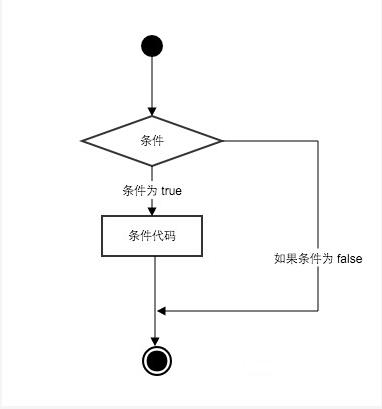
Python程序语言指定任何非0和非空(null)值为true,0 或者 null为false。
Python 编程中 if 语句用于控制程序的执行,基本形式为:
if 判断条件: 执行语句…… else: 执行语句……
其中"判断条件"成立时(非零),则执行后面的语句,而执行内容可以多行,以缩进来区分表示同一范围。
else 为可选语句,当需要在条件不成立时执行内容则可以执行相关语句。
具体例子如下:
#!/usr/bin/python # -*- coding: UTF-8 -*- # 例1:if 基本用法 flag = False name = 'lizexiong' if name == 'python': # 判断变量是否为 python flag = True # 条件成立时设置标志为真 print ('welcome lizexiong') # 并输出欢迎信息 else: print (name) # 条件不成立时输出变量名称 输出结果为: lizexiong # 输出结果
if 语句的判断条件可以用>(大于)、<(小于)、==(等于)、>=(大于等于)、<=(小于等于)来表示其关系。
当判断条件为多个值时,可以使用以下形式:
if 判断条件1: 执行语句1…… elif 判断条件2: 执行语句2…… elif 判断条件3: 执行语句3…… else: 执行语句4……
实例如下:
#!/usr/bin/python # -*- coding: UTF-8 -*- # 例2:elif用法 num = 5 if num == 3: # 判断num的值 print 'boss' elif num == 2: print 'user' elif num == 1: print 'worker' elif num < 0: # 值小于零时输出 print 'error' else: print 'lizexiong' # 条件均不成立时输出 输出结果为: lizexiong # 输出结果
由于 python 并不支持 switch 语句,所以多个条件判断,只能用 elif 来实现,如果判断需要多个条件需同时判断时,可以使用 or (或),表示两个条件有一个成立时判断条件成功;使用 and (与)时,表示只有两个条件同时成立的情况下,判断条件才成功。
#!/usr/bin/python # -*- coding: UTF-8 -*- # 例3:if语句多个条件 num = 9 if num >= 0 and num <= 10: # 判断值是否在0~10之间 print ('hello') # 输出结果: hello num = 10 if num < 0 or num > 10: # 判断值是否在小于0或大于10 print ('hello') else: print ('undefine') # 输出结果: undefine num = 8 # 判断值是否在0~5或者10~15之间 if (num >= 0 and num <= 5) or (num >= 10 and num <= 15): print ('hello') else: print ('undefine') # 输出结果: undefine
当if有多个条件时可使用括号来区分判断的先后顺序,括号中的判断优先执行,此外 and 和 or 的优先级低于>(大于)、<(小于)等判断符号,即大于和小于在没有括号的情况下会比与或要优先判断。
1.1 简单的语句组
你也可以在同一行的位置上使用if条件判断语句,如下实例:
#!/usr/bin/python # -*- coding: UTF-8 -*- var = 100 if ( var == 100 ) : print ("变量 var 的值为100") print ("Good bye!") 以上代码执行输出结果如下: 变量 var 的值为100 Good bye!
2.Python 循环语句
本章节将向大家介绍Python的循环语句,程序在一般情况下是按顺序执行的。
编程语言提供了各种控制结构,允许更复杂的执行路径。
循环语句允许我们执行一个语句或语句组多次,下面是在大多数编程语言中的循环语句的一般形式:
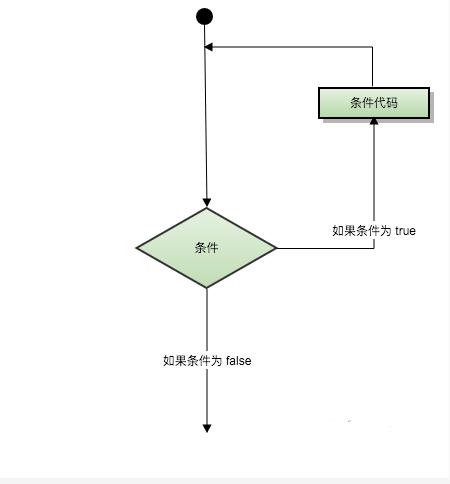
Python 提供了 for 循环和 while 循环(在 Python 中没有 do..while 循环):

循环控制语句
循环控制语句可以更改语句执行的顺序。Python支持以下循环控制语句:

2.1 While 循环语句
Python 编程中 while 语句用于循环执行程序,即在某条件下,循环执行某段程序,以处理需要重复处理的相同任务。其基本形式为:
while 判断条件(condition): 执行语句(statements)……
执行语句可以是单个语句或语句块。判断条件可以是任何表达式,任何非零、或非空(null)的值均为true。
当判断条件假 false 时,循环结束。
执行流程图如下:
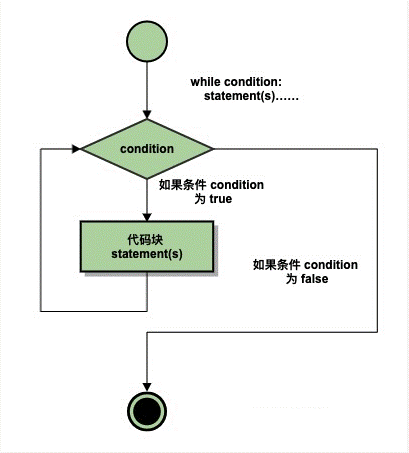
Gif 演示 Python while 语句执行过程
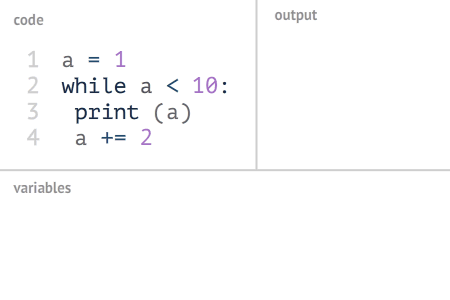
复杂一点:
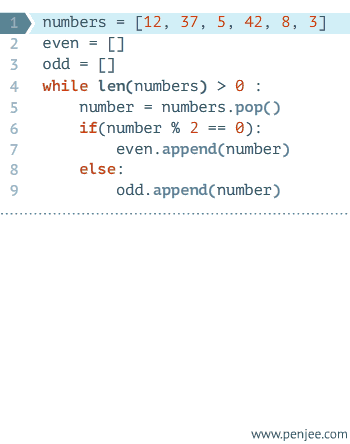
#实例 #!/usr/bin/python count = 0 while (count < 9): print ('The count is:', count) count = count + 1 print "Good bye!" 运行实例 » 以上代码执行输出结果: The count is: 0 The count is: 1 The count is: 2 The count is: 3 The count is: 4 The count is: 5 The count is: 6 The count is: 7 The count is: 8 Good bye!
while 语句时还有另外两个重要的命令 continue,break 来跳过循环,continue 用于跳过该次循环,break 则是用于退出循环,此外"判断条件"还可以是个常值,表示循环必定成立,具体用法如下:
2.1.1 continue 和 break 简介
# continue 和 break 用法 #后面章节会详细讲解 i = 1 while i < 10: i += 1 if i%2 > 0: # 非双数时跳过输出 continue print (i) # 输出双数2、4、6、8、10 i = 1 while 1: # 循环条件为1必定成立 print (i) # 输出1~10 i += 1 if i > 10: # 当i大于10时跳出循环 break
2.1.2 无限循环
如果条件判断语句永远为 true,循环将会无限的执行下去,如下实例:
#!/usr/bin/python # -*- coding: UTF-8 -*- var = 1 while var == 1 : # 该条件永远为true,循环将无限执行下去 num = raw_input("Enter a number :") print ("You entered: ", num) print "Good bye!" 以上实例输出结果: Enter a number :20 You entered: 20 Enter a number :29 You entered: 29 Enter a number :3 You entered: 3 Enter a number between :Traceback (most recent call last): File "test.py", line 5, in <module> num = raw_input("Enter a number :") KeyboardInterrupt
注意:以上的无限循环你可以使用 CTRL+C 来中断循环。
2.1.3 循环使用 else 语句
在 python 中,while … else 在循环条件为 false 时执行 else 语句块:
#!/usr/bin/python count = 0 while count < 5: print (count, " is less than 5") count = count + 1 else: print (count, " is not less than 5") 以上实例输出结果为: 0 is less than 5 1 is less than 5 2 is less than 5 3 is less than 5 4 is less than 5 5 is not less than 5
2.1.4 简单语句组
类似 if 语句的语法,如果你的 while 循环体中只有一条语句,你可以将该语句与while写在同一行中, 如下所示:
#!/usr/bin/python flag = 1 while (flag): print ('Given flag is really true!') print ("Good bye!")
注意:以上的无限循环你可以使用 CTRL+C 来中断循环。
2.2 for 循环语句
Python for循环可以遍历任何序列的项目,如一个列表或者一个字符串。
语法:
for循环的语法格式如下:
for iterating_var in sequence: statements(s)
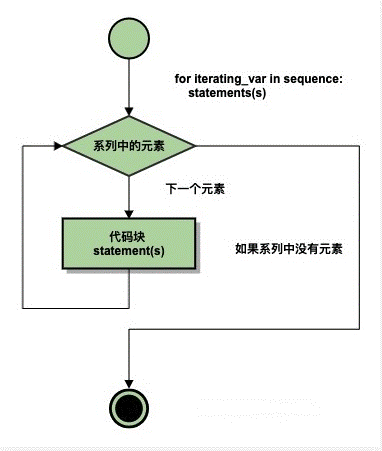
实例:
#!/usr/bin/python # -*- coding: UTF-8 -*- for letter in 'Python': # 第一个实例 print("当前字母: %s" % letter) fruits = ['banana', 'apple', 'mango'] for fruit in fruits: # 第二个实例 print ('当前水果: %s'% fruit) print ("Good bye!") 以上实例输出结果: 当前字母: P 当前字母: y 当前字母: t 当前字母: h 当前字母: o 当前字母: n 当前水果: banana 当前水果: apple 当前水果: mango Good bye!
2.2.1 通过序列索引迭代
另外一种执行循环的遍历方式是通过索引,如下实例:
#!/usr/bin/python # -*- coding: UTF-8 -*- fruits = ['banana', 'apple', 'mango'] for index in range(len(fruits)): print ('当前水果 : %s' % fruits[index]) print ("Good bye!") 以上实例输出结果: 当前水果 : banana 当前水果 : apple 当前水果 : mango Good bye!
以上实例我们使用了内置函数 len() 和 range(),函数 len() 返回列表的长度,即元素的个数。 range返回一个序列的数。
2.2.2 循环使用 else 语句
在 python 中,for … else 表示这样的意思,for 中的语句和普通的没有区别,else 中的语句会在循环正常执行完(即 for 不是通过 break 跳出而中断的)的情况下执行,while … else 也是一样。
#!/usr/bin/python # -*- coding: UTF-8 -*- for num in range(10,20): # 迭代 10 到 20 之间的数字 for i in range(2,num): # 根据因子迭代 if num%i == 0: # 确定第一个因子 j=num/i # 计算第二个因子 print ('%d 等于 %d * %d' % (num,i,j)) break # 跳出当前循环 else: # 循环的 else 部分 print ('%d 是一个质数' % num) 以上实例输出结果: 10 等于 2 * 5 11 是一个质数 12 等于 2 * 6 13 是一个质数 14 等于 2 * 7 15 等于 3 * 5 16 等于 2 * 8 17 是一个质数 18 等于 2 * 9 19 是一个质数
2.3 循环嵌套
Python 语言允许在一个循环体里面嵌入另一个循环。
Python for 循环嵌套语法:
for iterating_var in sequence: for iterating_var in sequence: statements(s) statements(s)
Python while 循环嵌套语法:
while expression: while expression: statement(s) statement(s)
你可以在循环体内嵌入其他的循环体,如在while循环中可以嵌入for循环, 反之,你可以在for循环中嵌入while循环。
实例:
以下实例使用了嵌套循环输出2~100之间的素数:
#!/usr/bin/python # -*- coding: UTF-8 -*- i = 2 while(i < 100): j = 2 while(j <= (i/j)): if not(i%j): break j = j + 1 if (j > i/j) : print (i, " 是素数") i = i + 1 print ("Good bye!") 结果输出: 2 是素数 3 是素数 .... 97 是素数 Good bye!
3.循环控制语句
3.1 break 语句
Python break语句,就像在C语言中,打破了最小封闭for或while循环。
break语句用来终止循环语句,即循环条件没有False条件或者序列还没被完全递归完,也会停止执行循环语句。
break语句用在while和for循环中。
如果您使用嵌套循环,break语句将停止执行最深层的循环,并开始执行下一行代码。
Python语言 break 语句语法:
break
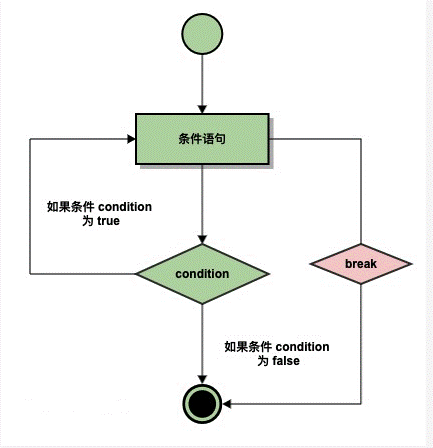
#!/usr/bin/python # -*- coding: UTF-8 -*- for letter in 'Python': # 第一个实例 if letter == 'h': break print ('当前字母 :', letter) var = 10 # 第二个实例 while var > 0: print ('当前变量值 :', var) var = var -1 if var == 5: # 当变量 var 等于 5 时退出循环 break print ("Good bye!") 以上实例执行结果: 当前字母 : P 当前字母 : y 当前字母 : t 当前变量值 : 10 当前变量值 : 9 当前变量值 : 8 当前变量值 : 7 当前变量值 : 6 Good bye!
3.2 continue 语句
Python continue 语句跳出本次循环,而break跳出整个循环。
continue 语句用来告诉Python跳过当前循环的剩余语句,然后继续进行下一轮循环。
continue语句用在while和for循环中。
Python 语言 continue 语句语法格式如下:
continue
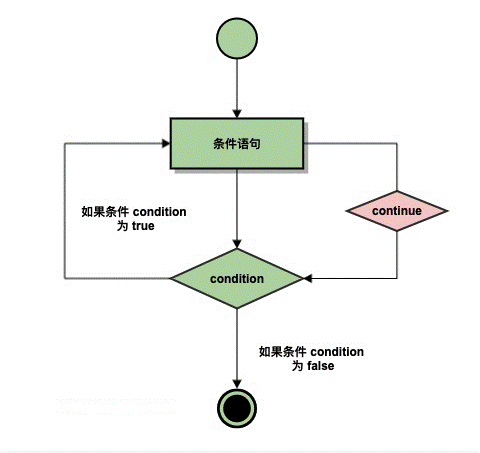
#!/usr/bin/python # -*- coding: UTF-8 -*- for letter in 'Python': # 第一个实例 if letter == 'h': continue print ('当前字母 :', letter) var = 10 # 第二个实例 while var > 0: var = var -1 if var == 5: continue print ('当前变量值 :', var) print ("Good bye!") 以上实例执行结果: 当前字母 : P 当前字母 : y 当前字母 : t 当前字母 : o 当前字母 : n 当前变量值 : 9 当前变量值 : 8 当前变量值 : 7 当前变量值 : 6 当前变量值 : 4 当前变量值 : 3 当前变量值 : 2 当前变量值 : 1 当前变量值 : 0 Good bye!
3.3 pass 语句
Python pass 是空语句,是为了保持程序结构的完整性。
pass 不做任何事情,一般用做占位语句。
Python 语言 pass 语句语法格式如下:
pass
实例
#!/usr/bin/python # -*- coding: UTF-8 -*- # 输出 Python 的每个字母 for letter in 'Python': if letter == 'h': pass print ('这是 pass 块') print ('当前字母 :', letter) print ("Good bye!") 以上实例执行结果: 当前字母 : P 当前字母 : y 当前字母 : t 这是 pass 块 当前字母 : h 当前字母 : o 当前字母 : n Good bye!







【推荐】国内首个AI IDE,深度理解中文开发场景,立即下载体验Trae
【推荐】编程新体验,更懂你的AI,立即体验豆包MarsCode编程助手
【推荐】抖音旗下AI助手豆包,你的智能百科全书,全免费不限次数
【推荐】轻量又高性能的 SSH 工具 IShell:AI 加持,快人一步
· TypeScript + Deepseek 打造卜卦网站:技术与玄学的结合
· 阿里巴巴 QwQ-32B真的超越了 DeepSeek R-1吗?
· 【译】Visual Studio 中新的强大生产力特性
· 10年+ .NET Coder 心语 ── 封装的思维:从隐藏、稳定开始理解其本质意义
· 【设计模式】告别冗长if-else语句:使用策略模式优化代码结构